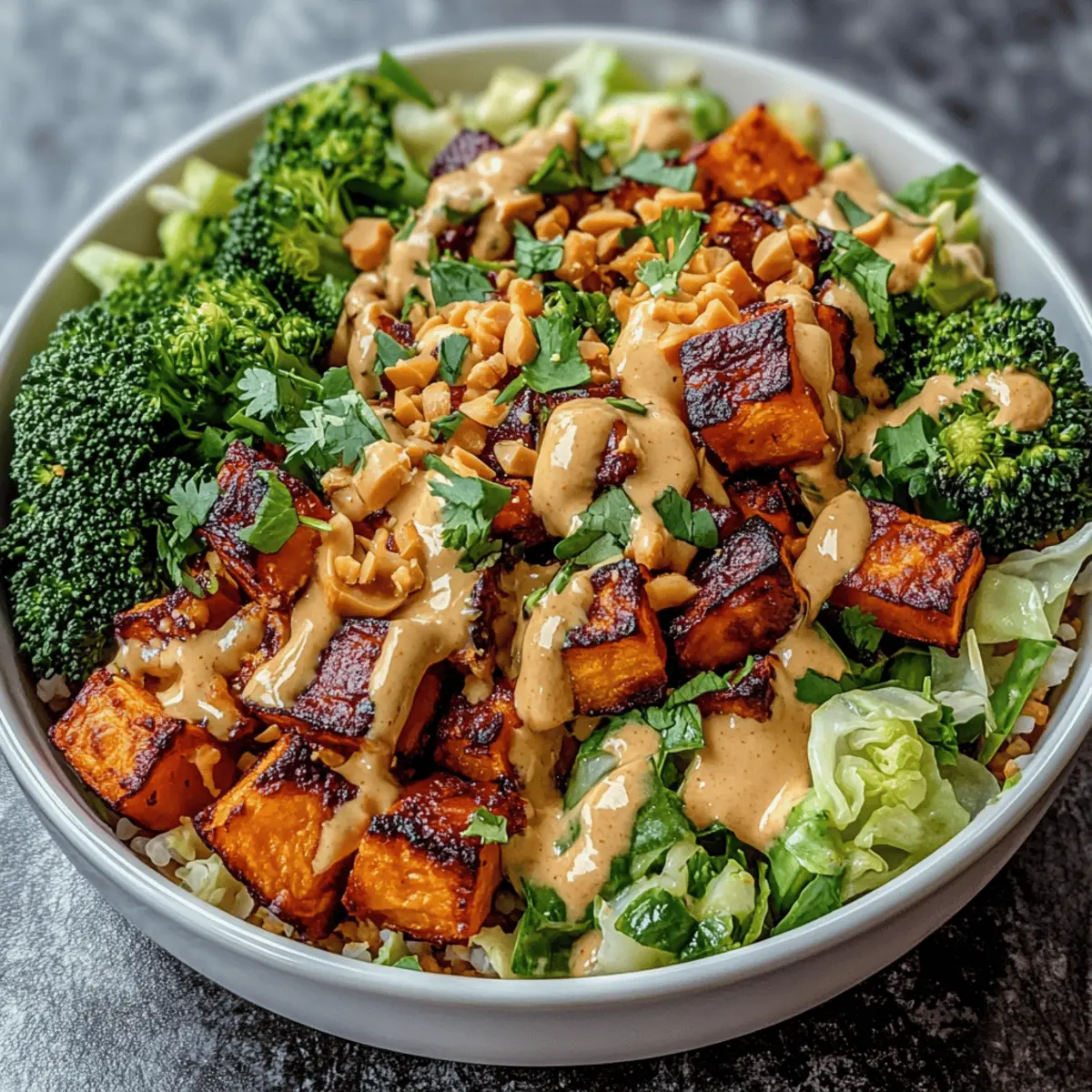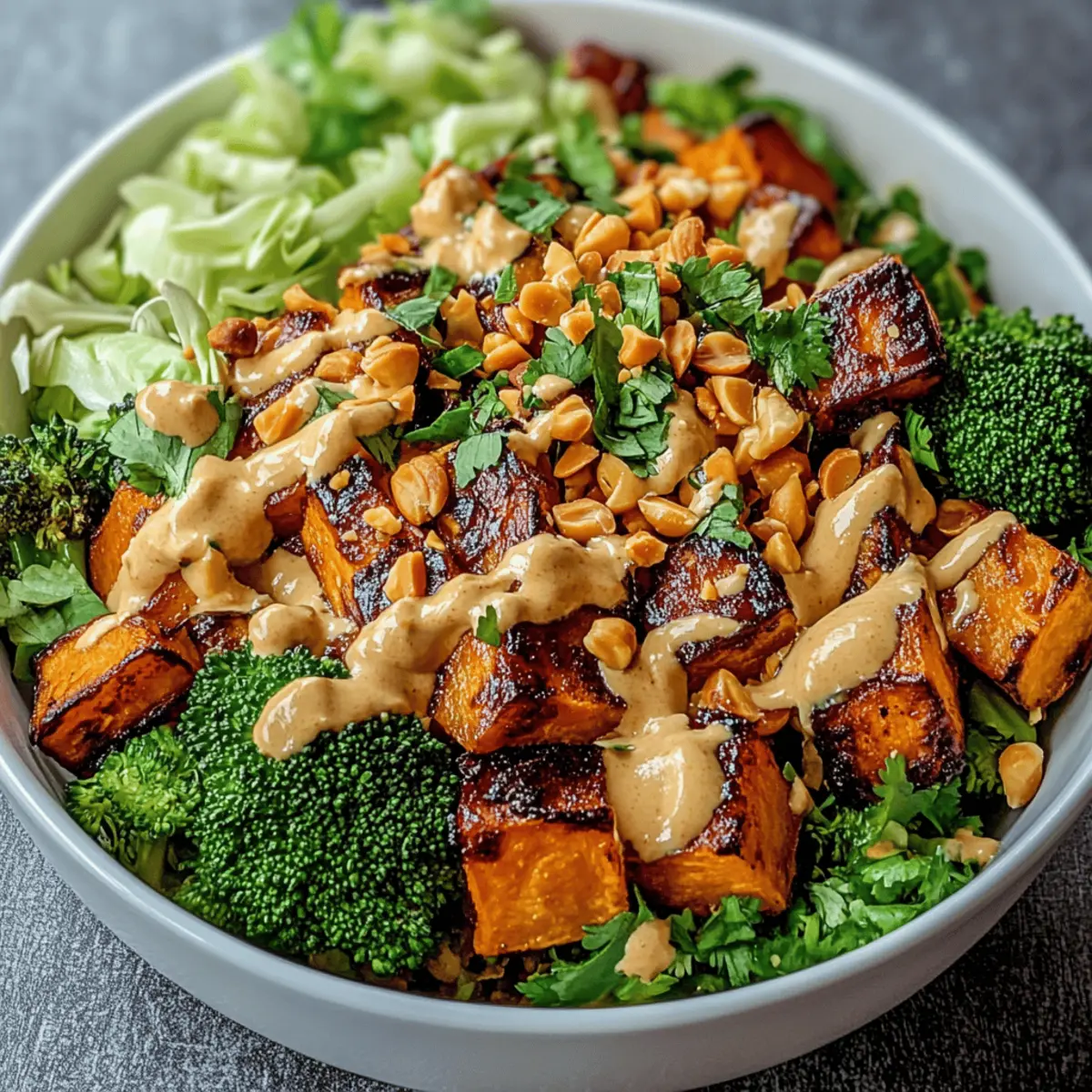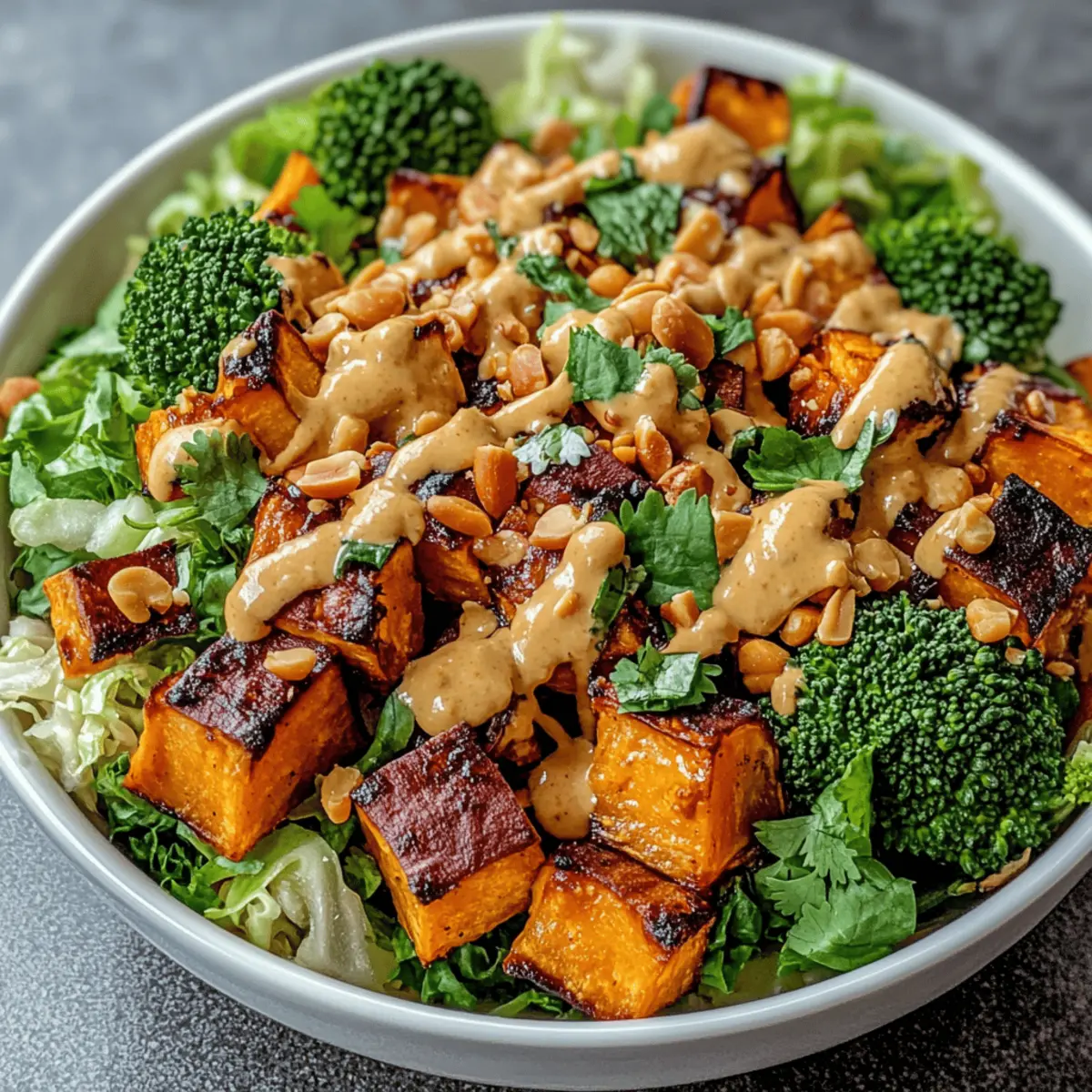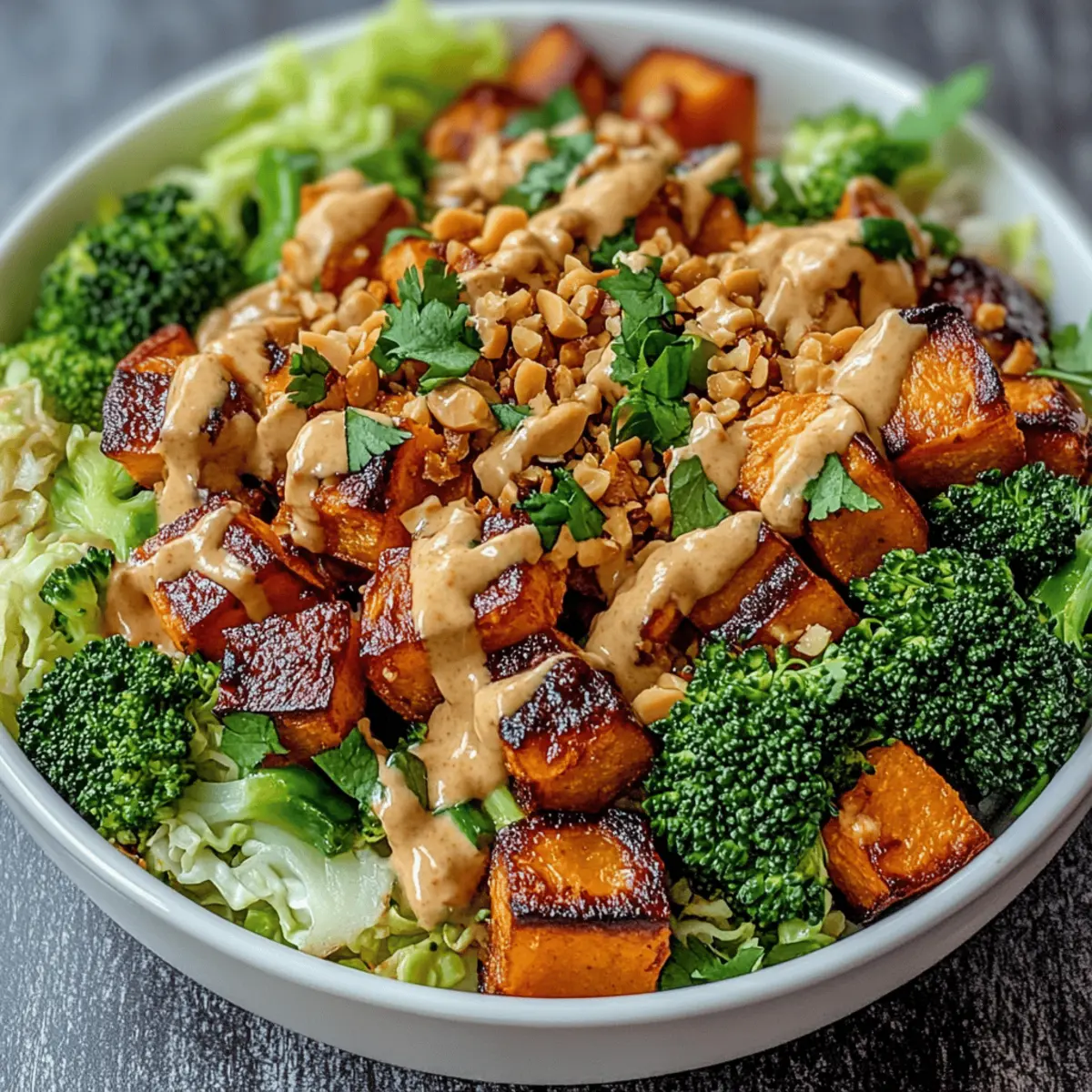As I was flipping through my recipe notebook one cozy afternoon, I stumbled upon a delightful creation I hadn’t made in ages: the Thai Peanut Sweet Potato Buddha Bowl. This vibrant dish offers a feast for both the eyes and the palate, showcasing a colorful medley of roasted sweet potatoes, crunchy veggies, and a creamy peanut sauce that ties it all together. Perfect for meal prep or a quick weeknight dinner, this plant-based powerhouse is loaded with nutritious ingredients and heartwarming flavors. Whether you’re a seasoned home chef or just beginning your culinary journey, this Buddha bowl promises to satisfy your cravings without the fuss of takeout. Ready to elevate your weeknight meals? Let’s dive into the bliss of this wholesome recipe!
Why is this Buddha Bowl a must-try?
Colorful, Vibrant Ingredients: Each component adds its own pop—sweet potatoes, fresh greens, and garnishes create a dish that’s as beautiful as it is delicious.
Creamy Peanut Sauce: The rich sauce is a showstopper, blending nutty flavors that perfectly balance the bowl and keep each bite exciting.
Quick & Easy: With just a few simple steps, this meal can be prepped in under 30 minutes, making it perfect for busy weeknights.
Meal Prep Friendly: Prepare the components ahead of time for quick assembly during the week, allowing you to enjoy wholesome meals without the hassle.
Nutritious and Satisfying: Packed with vitamins and fiber, this plant-based dish not only fuels your body but also keeps your taste buds happy. Imagine serving this alongside Sticky Sweet Chili Chicken for those who prefer a meat option!
Thai Peanut Sweet Potato Buddha Bowl Ingredients
• Here are the essential ingredients you’ll need to create this delicious Buddha bowl:
For the Bowl
- Sweet Potatoes – The star ingredient; provides sweetness and substance; can substitute with butternut squash for a similar effect.
- Olive Oil – Used for roasting; enhances the flavor of sweet potatoes; can substitute with avocado oil.
- Salt and Pepper – Basic seasonings to taste; essential for enhancing all flavors.
- Broccoli Florets – Adds crunch and nutrition; can use cauliflower for a milder flavor.
- Shredded Cabbage – Provides texture and additional nutrients; can swap with spinach for a softer option.
- Grated Carrots – Offers sweetness and color; no substitute necessary, though zucchini could work in a pinch.
- Avocado – Creamy element that adds healthy fats; can replace with hummus for a different texture.
For the Peanut Sauce
- Peanut Butter – Key flavor in the sauce, provides nuttiness and creaminess; use almond butter if allergic to peanuts.
- Soy Sauce – Adds umami and saltiness; tamari is a gluten-free alternative.
- Maple Syrup – Sweetens the sauce; agave syrup can be a good substitute.
- Lime Juice – Brightens flavors and adds acidity; lemon juice could be used instead.
- Sesame Oil – Infuses a distinct flavor; substitute with olive oil if necessary.
For Garnish
- Cilantro and Peanuts – Enhance flavor and texture; can use green onions for garnish instead.
This Thai Peanut Sweet Potato Buddha Bowl is a perfect centerpiece for your healthy meal options!
Step‑by‑Step Instructions for Thai Peanut Sweet Potato Buddha Bowl
Step 1: Preheat the Oven
Begin by preheating your oven to 400°F (200°C). This will ensure a hot cooking environment for your sweet potatoes, allowing them to roast beautifully. While the oven heats up, prepare your baking sheet by lining it with parchment paper for easy cleanup and to prevent sticking.
Step 2: Prepare the Sweet Potatoes
Dice your sweet potatoes into even cubes for consistent cooking. Arrange them in a single layer on the prepared baking sheet, then drizzle generously with olive oil, sprinkling with salt and pepper to enhance their natural sweetness. Roast in the preheated oven for 25-30 minutes, turning halfway, until they are golden-brown and crispy on the edges, inviting you with their enticing aroma.
Step 3: Mix the Fresh Vegetables
While the sweet potatoes roast, chop your broccoli florets, shred the cabbage, and grate the carrots. In a large mixing bowl, combine these fresh veggies with diced avocado to add creaminess. Set aside to keep them crisp and colorful, ensuring they’ll provide a delightful crunch against the sweet potatoes in your Thai Peanut Sweet Potato Buddha Bowl.
Step 4: Whisk the Peanut Sauce
In a small bowl, prepare your creamy peanut sauce by whisking together peanut butter, soy sauce, maple syrup, lime juice, and sesame oil. Blend these ingredients until smooth and cohesive, adjusting sweetness and acidity to your liking. The sauce should be rich and velvety, ready to elevate the flavors of your Buddha bowl.
Step 5: Assemble the Bowl
Once the sweet potatoes are nicely roasted, it’s time to assemble your bowl. Start by layering the mixed vegetables at the bottom of a serving bowl, creating a vibrant base. Next, add the crispy sweet potatoes on top, and generously drizzle the prepared peanut sauce over everything, ensuring each bite will be bursting with flavor.
Step 6: Garnish and Serve
Finish your Thai Peanut Sweet Potato Buddha Bowl by garnishing it with fresh cilantro and crushed peanuts for an added crunch. If desired, sprinkle some extra lime juice or green onions for more flavor. Serve immediately while warm, or enjoy as an easy meal-prep dish by storing components separately in the fridge for up to three days.
Storage Tips for Thai Peanut Sweet Potato Buddha Bowl
-
Fridge: Store leftover components separately in airtight containers for up to 3 days. This keeps the vegetables fresh and maintains their crunchiness.
-
Freezer: While the sweet potatoes can be frozen for later use, it’s best to avoid freezing the assembled bowl, as thawing can affect the texture. Use within 2 months for best quality.
-
Reheating: When ready to enjoy your Thai Peanut Sweet Potato Buddha Bowl again, reheat sweet potatoes in the oven or microwave until warmed through. Keep the peanut sauce separate until serving to maintain its creamy consistency.
-
Meal Prep: Preparing the elements ahead of time allows for quick assembly during the week. Just remember to store everything in the fridge, so it’s ready whenever you need a nutritious meal.
What to Serve with Thai Peanut Sweet Potato Buddha Bowl
Elevate your meal with delightful pairings that enhance the flavors and textures of this vibrant dish.
- Coconut Rice: The subtle sweetness of coconut rice beautifully complements the savory peanut sauce, creating a tropical harmony that is irresistible.
- Grilled Tofu: For added protein and a smoky flavor, grilled tofu enhances the dish while keeping it entirely plant-based. Enjoy it marinated in soy sauce for a delicious twist.
- Spicy Edamame: These tender soybeans sprinkled with sea salt and chili flakes elevate your Buddha bowl by adding a spicy crunch, perfect for nibbling between bites.
- Mango Salad: A refreshing mango salad brings a sweet and tangy contrast, balancing the richness of the peanut sauce while adding bright colors and citrusy notes.
- Crispy Chickpeas: Roasted chickpeas offer a satisfying crunch that mirrors the textures in your Buddha bowl while adding fiber and protein—perfect for a wholesome touch.
- Ginger Lime Sparkler: Pair your meal with a refreshing drink such as ginger lime soda, which cleanses the palate and enhances the flavors, making every bite even more enjoyable.
- Chocolate Avocado Mousse: For dessert, a silky chocolate avocado mousse, with its rich, creamy texture, perfectly follows the bowl’s flavors without overwhelming the palate.
- Pickled Vegetables: Add zesty pickled vegetables to the table for an intriguing tanginess that cuts through the richness of the peanut sauce, giving an exciting flourish to each mouthful.
- Crispy Naan: For those wanting a little indulgence, serving warm, crispy naan bread on the side allows you to scoop up every bit of the luscious bowl, combining flavors in a delightful way.
- Fruit Sorbet: Finish with a light and fruity sorbet to cleanse your palate, providing a refreshing end to this colorful meal adventure.
Expert Tips
-
Even Dicing: Ensure your sweet potatoes are cut into uniform cubes for consistent cooking. This prevents some pieces from being undercooked while others become overly crispy.
-
Veggie Variations: Don’t hesitate to customize your Buddha Bowl. Adding different veggies, like bell peppers or kale, can enhance flavor and nutrition in your Thai Peanut Sweet Potato Buddha Bowl.
-
Proper Storage: Keep leftover components separate in the fridge to maintain freshness and prevent sogginess. The sweet potatoes can be reheated before assembly.
-
Peanut Sauce Adjustments: Taste your peanut sauce before serving. Adjust the sweetness and acidity according to your preference—more lime juice can brighten up the dish wonderfully!
-
Crunch Factor: For an extra crunch, consider adding toppings like crushed toasted peanuts or seeds on your Buddha Bowl just before serving.
Thai Peanut Sweet Potato Buddha Bowl Variations
Feel free to get creative and personalize your Buddha bowl experience with these delightful twists!
-
Vegetable Swap: Incorporate kale, bell peppers, or snap peas for added flavor and texture. Each vegetable brings a unique crispness that enhances the bowl’s overall crunch.
-
Protein Boost: Add chickpeas, grilled tofu, or edamame for a protein hit. These additions will make your bowl even heartier and more satisfying.
-
Spicy Kick: Stir in a little sriracha or sprinkle chili flakes into the peanut sauce for an extra layer of heat. You might be surprised by how much a little spice can awaken the dish!
-
Creamy Alternative: Replace avocado with hummus for a different, creamy texture that still packs in nutrition. This swap offers a delightful twist without sacrificing flavor.
-
Nut Butters: If you’re looking for a nut-free version, try using sunbutter or tahini instead of peanut butter in your sauce—it’ll provide a similar creaminess and depth.
-
Grain Variation: Serve your Buddha bowl over quinoa, brown rice, or farro for added texture and heartiness. Switching your base can transform the experience completely!
-
Fruity Addition: Toss in some diced mango or pineapple for a sweet contrast to the savory flavors; their natural sweetness will brighten up every bite.
-
Herbal Infusion: Experiment with garnishes—try fresh mint or basil instead of cilantro for a refreshing twist that adds unexpected layers of flavor.
These variations ensure that every version of your Thai Peanut Sweet Potato Buddha Bowl remains a delightful culinary adventure! For more cozy meal prep inspiration, check out our Ground Beef Potato and Cheesy Garlic Potato recipes to expand your cooking repertoire!
Make Ahead Options
These Thai Peanut Sweet Potato Buddha Bowls are perfect for busy home cooks looking to save time! You can roast the sweet potatoes and prepare the peanut sauce up to 3 days in advance. Simply roast the diced sweet potatoes (tossed in olive oil, salt, and pepper) and store them in an airtight container in the fridge. The peanut sauce can also be made ahead by whisking together peanut butter, soy sauce, maple syrup, lime juice, and sesame oil, and refrigerating it until you’re ready to enjoy the bowl. Just assemble by layering the fresh vegetables and reheating the sweet potatoes before serving, and you’ll have a nutritious meal ready to go with minimal effort!
Thai Peanut Sweet Potato Buddha Bowl Recipe FAQs
What should I look for when selecting sweet potatoes?
Absolutely! When choosing sweet potatoes, look for those that are firm, smooth, and free from dark spots or blemishes. Avoid any soft or shriveled potatoes as they may be past their prime. A good rule of thumb is to select medium-sized sweet potatoes for even cooking.
How do I store leftovers from the Buddha bowl?
Very good question! Store leftover components separately in airtight containers in the refrigerator for up to 3 days. This keeps the vegetables crisp and prevents sogginess. Reheat the sweet potatoes before serving but keep the peanut sauce separate until you’re ready to enjoy your Thai Peanut Sweet Potato Buddha Bowl again.
Can I freeze leftovers, and if so, how?
Yes, you can freeze the sweet potatoes for later use! To do so, allow them to cool completely after roasting, then transfer them to freezer-safe bags or airtight containers. They can be frozen for up to 2 months. When ready to eat, simply reheat the sweet potatoes in the oven or microwave until warmed through. However, it’s best not to freeze the assembled bowl as it may affect the texture of the fresh vegetables and sauce.
What if I have a peanut allergy?
No problem at all! If you or someone you’re serving has a peanut allergy, you can substitute peanut butter with almond butter or sunflower seed butter; these alternatives will still provide a satisfying creaminess without the allergens. Just ensure any other added ingredients are also allergy-friendly.
How do I prevent my sweet potatoes from becoming mushy?
To avoid mushy sweet potatoes, it’s essential to cut them into uniform cubes, about 1 inch in size. This allows them to roast evenly. Also, make sure to give them enough space on the baking sheet—crowding can trap steam and lead to sogginess. Finally, roasting them at 400°F (200°C) will encourage a crispy exterior while keeping the inside tender yet firm.
Can I customize the veggies in my Buddha bowl?
The more the merrier! Feel free to switch out vegetables based on your preferences or what you have on hand. Veggies like bell peppers, snap peas, or kale can be excellent additions. The key is to maintain a mix of textures and colors for that beautiful presentation, plus it keeps the dish exciting each time you make it!

Thai Peanut Sweet Potato Buddha Bowl for a Flavorful Boost
Ingredients
Equipment
Method
- Preheat your oven to 400°F (200°C). Line a baking sheet with parchment paper.
- Dice sweet potatoes into even cubes, place on the baking sheet, drizzle with olive oil, and season with salt and pepper. Roast for 25-30 minutes.
- Chop broccoli, shred cabbage, and grate carrots. Combine with diced avocado in a mixing bowl.
- In a small bowl, whisk together peanut butter, soy sauce, maple syrup, lime juice, and sesame oil until smooth.
- Assemble the bowl by layering mixed veggies, topped with roasted sweet potatoes, and drizzle with peanut sauce.
- Garnish with cilantro and crushed peanuts before serving.




